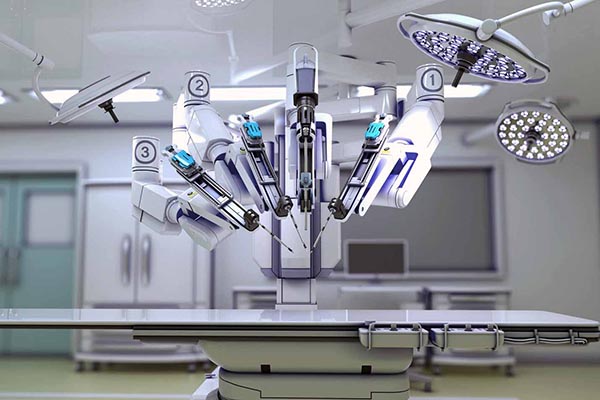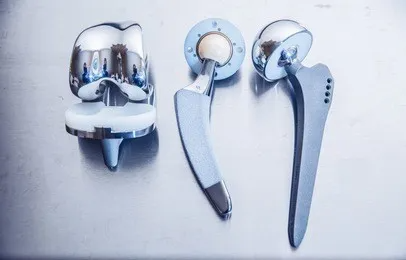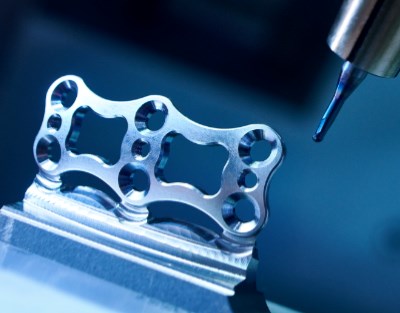In the ever-evolving world of manufacturing, technology continues to push the boundaries of what is possible. One such technological marvel that has revolutionized the production of medical implants is the advent of five-axis CNC machines. Five-axis CNC machines have revolutionized the manufacturing of orthopedic implants. Their remarkable precision and versatility have transformed the process. As a result, patient outcomes have improved significantly. This advancement has also marked a new era in medical implant design.
Fundamentally, CNC machining is a quicker and more accurate process than traditional methods. So, it can offer better performance and can meet stricter criteria. Some medical supplies are produced by manufacturers using plastic injection molding. High-quality molds for repeatable and uniform injection are also made possible by CNC machining. Let’s look at some more reasons why CNC machining are unmatched for the medical industry across the world.

CNC machining eliminates the need for specialized tools while creating highly accurate medical components at a reasonable cost. In contrast to other production techniques, this procedure requires less expensive tooling, saving both time and money.
For short production runs or custom items, precision CNC machining offers quicker turnaround times compared to specialist mold tooling, which can take up to four weeks. CNC machining shows to be the perfect answer in the medical sector where speedy and precise parts are usually needed in small quantities. Without the need for specialist tools, it produces results that are exact and of excellent quality.
Quick manufacture of medical components is made possible by medical CNC machining. Depending on how difficult they are, you can create final pieces in a short period of time. CNC production machining can supply high-quality parts in diverse quantities fast in medical crises where it is difficult to forecast what kinds of parts or components are needed.
CNC machining is more appropriate for smaller projects because it does not demand minimum order volumes like other manufacturing processes do. With CNC machining, a cutting program may be quickly created from a computerized CAD file.
This makes it possible to produce one or more custom-machined medical parts with a high degree of precision without needing to place a minimum order. Since one-off or single-use custom parts are commonly needed for highly specialized medical devices, equipment, surgical supplies, prosthetics, and other goods, CNC machining is the best option.

The capacity to quickly and effectively share digital plans between medical experts, product designers, and manufacturing experts is a significant benefit of CNC machining. No matter the location of necessity, this capability significantly increases its efficiency in producing high-quality and specific CNC machined medical equipment. When time is a crucial component, this benefit is very beneficial. It enables the quick production and distribution of crucial medical components.
Numerous complex medical equipment calls for extremely tight tolerances, which CNC machining can easily meet. This lessens the need for post-processing and lowers the possibility of mistakes. In addition to saving time and money, it guarantees that medical components are suitable for their intended use.
In the healthcare industry, even minor specifications changes can have detrimental effects. This risk is significantly decreased and high-quality parts may be produced thanks to the precision and accuracy of medical CNC machining.
Digital machining enables the use of portable CNC machines and the quick transfer of digital CAD files. Despite their low capacity, portable CNC machines can be used to produce straightforward medical components. With a few exceptions, the most typical materials used for medical and surgical equipment, appliances, and parts can be processed by ordinary CNC machines. These materials include of PEEK production-grade polymers, stainless steel, aluminum, and titanium.
Tolerances, malleability, and tension requirements are frequently taken into account when designing medical components. Designers also take sterilization and disposal requirements into account. Therefore, it's essential to select only the best CNC machining materials that satisfy functional and quality requirements.

Before we explore the impact of five-axis CNC machines on medical implants, let's understand these machines clearly. Let's delve into what they are and how they function.
A five-axis CNC machine is a computer-controlled machining tool. It can perform complex movements along five different axes. These axes include X, Y, Z, and two rotational axes. The rotational axes are referred to as A and B. This multi-axis capability allows for unprecedented freedom and precision in machining intricate and highly customized parts.
Today's market for machined medical parts demands extreme accuracy and adherence to rigid safety and performance standards. To guarantee the quality and efficacy of CNC machined medical equipment, it is essential to select the correct manufacturer for these vital components.
So, how do five-axis CNC machines contribute to the manufacturing of medical implants? The answer to their impact lies in their ability to produce complex geometries. These geometries are often intricate and difficult to achieve using traditional machining methods.
The human body is diverse, and each patient may have a unique implant tailored to their specific anatomy. Five-axis CNC machines enable manufacturers to produce implants matching patients' needs. This precise customization results in improved functionality and reduces post-operative complications.
One notable advantage of five-axis CNC machines is their ability to machine implants from various materials. Cobalt-chromium alloys, titanium, biocompatible polymers, and stainless steel are some of the materials in this list. This versatility is crucial in the medical field, where different materials offer varying strength levels, corrosion resistance, and biocompatibility. Manufacturers can choose the most suitable material for each implant with five-axis CNC machines. This ensures optimal performance and longevity of the implants.
Another critical benefit of five-axis CNC machines is their unparalleled precision. The human body is a delicate system. Even the slightest error in implant design or placement can have severe consequences. Five-axis CNC machines excel in producing implants with exceptionally tight tolerances. This ensures a precise fit and minimizes the risk of implant failure. The ability to achieve intricate features further enhances the implant's functionality. It includes porous structures or surface texturing. It also promotes better integration with the surrounding bone or tissue.
Moreover, the speed and efficiency of five-axis CNC machines have improved the production process of medical implants. Traditional methods, such as manual milling or casting, can be time-consuming and labor-intensive. In contrast, five-axis CNC machines can complete complex machining operations in a fraction of the time. This streamlined manufacturing workflow leads to reduced production costs. This efficiency benefits manufacturers by reducing production costs. It also enables healthcare providers to deliver implants more quickly to needy patients.
To illustrate the impact of five-axis CNC machines in the medical field, let's focus on YS650-5AX. The YS650-5AX is a cutting-edge five-axis machining center offered by CNC Yangsen.
This state-of-the-art machine is designed for precision machining applications, including medical implants. Its robust construction guarantees exceptional stability and accuracy during the machining process. Advanced control systems further enhance this. The YS650-5AX offers a maximum spindle speed of 12,000 RPM, allowing for high-speed machining. Its extensive work envelope also provides ample space for creating complex implant geometries. This combination of features empowers manufacturers to achieve efficient and precise results.
The YS650-5AX boasts various features, making it an ideal choice for machining medical implants. Its simultaneous five-axis machining capability enables the production of implants with undercuts, deep pockets, and intricate contours. The YS650-5AX is equipped with advanced toolpath generation software. This software plays a crucial role in ensuring smooth and efficient machining operations. Optimizing tool movements reduces cycle times and maximizes productivity. The result enables faster production of high-quality implants.
Furthermore, the YS650-5AX includes advanced cooling systems. These systems are designed to minimize heat-induced deformations in the workpiece. It ensures superior dimensional accuracy and surface finish.
The YS650-5AX offers several advantages through its 5-axis linkage and RTCP processing. These include the program pre-reading function. It avoids pauses during program segment conversion and ensures constant path speed. This leads to the best surface quality. The continuous path mode intelligently controls the trajectory at program segment junctions. It eliminates pauses and reduces processing time. The dynamic feedforward control prevents track deviation. It maintains accuracy even at increased speeds. Additionally, the dynamic compressor smooths the processing path. It maintains a constant curvature, ensuring optimal machining results.
| Model | YS650-5AX | ||
| Subject | Specifications | Units | |
| Travel | X/Y/Z axis | mm | 700/450/400 |
| Spindle Nose to Worktable | mm | 200-600 | |
| Spindle Center to Column | mm | 400 | |
| Three-Axis Guideway | / | Roller Linear Guideway | |
| Worktable | Worktable Size (L*W) | mm | Φ650 |
| Maximum Table Load | kg | 200 | |
| Countertop bolt hole | mm | / | |
| T-Slot | mm | 5-18x100 | |
| Worktable Indexing | / | 0.001° | |
| Spindle | Spindle taper | type | HSKA63 |
| Spindle speed | rpm | 18000 | |
| Spindle Drive Type | / | Built-In | |
| Feedrate | Rapid Traverse (X/Y/Z) | m/min | 30/30/30 |
| Cutting Feedrate (X/Y/Z) | m/min | 10 | |
| Tool Changer | Automatic Tool Changer | / | ARM |
| Motor | Spindle Motor | kw | 20 |
| Three-Axis Servo Motor | kw | 30/30/30 | |
| Accuracy | Accuracy | mm | ±0.005 |
| Repeatability | mm | ±0.003 | |
| Power Required | Power Requirement | kva | 30 |
| Air Pressure Requirement | kg/cm² | 6^8 | |
| Others | External Dimensions (L*W*H) | mm | / |
| Gross Weight | t | 12 | |
The YS650-5AX features the German Siemens 840D system. It provides powerful functions and precise control over the machining process. The machine is equipped with a DD motorΦ650 five-axis rotating worktable.
The machine also incorporates a servo tool magazine. It allows for quick tool changes and improves processing efficiency. With top-of-the-line components and configurations, the YS650-5AX offers reliability. It also provides performance in medical implant manufacturing.
The machine body of the YS650-5AX is made of HT300 resin sand castings, ensuring high rigidity and stability. The overall annealing enhances the machine's ability to maintain its structural integrity. The natural aging treatment further enhances the machine's ability to maintain its structural integrity. Two high-frequency vibration aging treatments further improve the device.
The high-speed and high-precision electric spindle with 20,000 rpm provides the cutting ability required for precise implant manufacturing. The X, Y, and Z axes have high-precision ballscrew pairs. They offer fast response, stability, and high transmission accuracy. These features eliminate transmission gaps and ensure machining accuracy.
Using five-axis CNC machines in the medical field has led to significant advancements in recent years. These advancements are seen in implant design and functionality. Orthopedic implants, such as hip replacements, knee replacements, and spinal implants, can now be custom-made. This customization allows them to match the patient's unique anatomy precisely. This level of customization improves the fit and comfort of the implant. It also reduces the risk of complications and improves patient outcomes.
Five-axis CNC machines creating porous structures within implants have transformed the field. Porous implants promote bone ingrowth, improving integration with natural bone. This enhances implant stability and longevity, reducing the risk of loosening or failure.
Additionally, surface texturing capabilities enable implants with enhanced osseointegration properties. This improves the implant's long-term success rate.
The application of five-axis CNC machines is not limited to metal implants. These machines are also used in the production of patient-specific polymer implants. Examples include cranial plates and facial implants. The ability to precisely machine biocompatible polymers has a significant impact. It allows for the creation of implants that closely mimic the natural tissues. This is true in terms of both mechanical properties and aesthetics. This opens up new possibilities for reconstructive surgeries. It also opens up opportunities for cosmetic procedures. These procedures provide patients with implants that are functional and visually appealing.

The emergence of five-axis CNC machines has revolutionized the manufacturing of medical implants. Through their precision, these machines have redefined how orthopedic implants are designed. They have also redefined the way orthopedic implants are produced. These machines have achieved this through their versatility and efficiency. The level of precision they offer are unmatched in today’s world of medical components.
The ability to create patient-specific implants has significantly improved patient outcomes. This is due to complex geometries and tight tolerances. Additionally, it has reduced the risk of complications. As technology advances, we can expect further innovations in medical implant manufacturing. These innovations will ultimately benefit patients and healthcare providers alike.